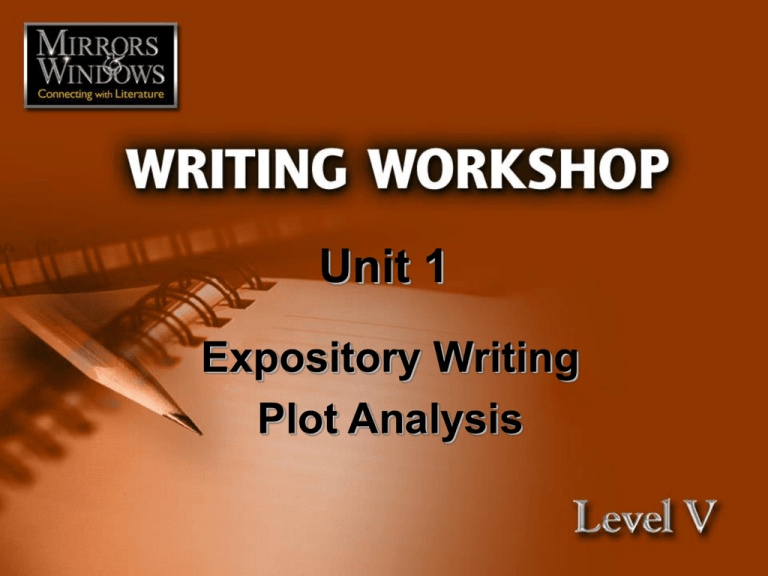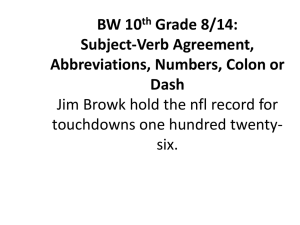Writing Workshop
advertisement

Unit 1 Expository Writing Plot Analysis Plot Analysis What is a plot analysis? • A plot analysis takes a story apart and examines it piece by piece in order to discover what makes it work. • An analysis considers how plot elements— including exposition, rising action, climax, falling action, and resolution—work together to create a good story. • A plot analysis is a way to interpret the story to gain a deeper understanding of both content and form. Plot Analysis Assignment • Choose a story from this unit and write a plot analysis, using the three-part process – prewriting, drafting, and revising Purpose • To provide insight into how and why the elements of plot work in a specific story Audience • Your teacher and classmates; people who have read the story Writing Rubric A successful plot analysis: states the title, author, and brief summary of the story in the introduction presents a clear thesis statement expressing the main idea of the analysis develops body paragraphs that support the thesis, identify what happens in each element of the plot, and cite details and brief quotations from the story concludes by summarizing the analysis and restating the thesis is written in complete sentences ➊ PREWRITE Select Your Topic • Choose a story from this unit to analyze. • Select one that was most compelling for you to read and that interests you most. ➊ PREWRITE Gather Information • Reread the story you have chosen to analyze. Identify what happens in each stage. —Note that plot elements will vary in order and importance depending on the story. • Jot down events in a Plot Diagram like the one below. Climax Rising Action Exposition Falling Action Resolution ➊ PREWRITE Gather Information • Note any important details that may affect the development of the conflict or resolution. • Copy quotations you may want to refer to in your essay. • Use a Plot Element Chart to write down the information you have gathered. On the next slide, you will practice filling out a Plot Element Chart as a class. Plot Element Chart Title: Story Details Exposition Inciting Incident Rising Action Climax Falling Action Resolution Dénouement Thesis Idea: Significance/ Ideas Quotations ➊ PREWRITE Organize Your Ideas • Once you isolate and examine the plot elements, you can look at the story analytically to see how it works and to gain insight into the plot. • To focus your ideas, review your Plot Element Chart and ask yourself these questions: —What is the author’s most impressive accomplishment in the story? —What plot feature offers surprise, shock, or emotional depth? —What plot device creates the turning point in the story? ➊ PREWRITE Organize Your Ideas • Create an organizational plan for your essay using your Plot Element Chart. • Number or list the plot elements in the order they logically appear—the same order they appeared in the story. • Highlight information that is important and relevant to your analysis. • Cross out irrelevant, unnecessary information. ➊ PREWRITE Write Your Thesis Statement • Examine your notes and write a statement capturing the main point of your plot analysis. This is your thesis statement. • One student wrote this thesis statement about the plot of Edgar Allan Poe’s “The Masque of the Red Death”: The sad story turns to horror because of Prospero’s vain belief that he can escape the fate of the Red Death. Edgar Allan Poe used long and short sentences in “The Masque of the Red Death.” Notice the example below: But the Prince Prospero was happy and dauntless and sagacious. When his dominions were half depopulated, he summoned to his presence a thousand hale and light-hearted friends from among the knights and dames of his court, and with these retired to the deep seclusion of one of his castellated abbeys. ➋ DRAFT Write your essay by following this three-part framework: Introduction Body Conclusion ➋ DRAFT Introduction • Provide the title, author, and a summary of the story. • Include the thesis statement of your analysis. Body • Write an in-depth analysis by expanding on the thesis. • Include details and quotations from the story to illustrate your points about the plot elements. Conclusion • Rephrase the thesis statement, summarize the analysis, and give the essay a sense of closure. ➋ DRAFT Draft Your Introduction • In a plot analysis, the introduction identifies the author and title of the story and briefly summarizes its plot or theme. • The introduction also states the thesis, establishing the main idea of the analysis. • Finally, a good introduction creates interest, drawing readers into the rest of the essay. ➋ DRAFT Draft Your Body • In the body, write about plot elements in the order they occur in the story. — Start with exposition and end with dénouement. • State each point you want to make, and support it with evidence. —Include details, ideas, and brief quotations from the text. • Every detail should relate to the main point you make about the plot in your thesis statement. ➋ DRAFT Draft Your Conclusion • Finally, write a good conclusion that —restates the thesis —summarizes the analysis —provides closure to the essay —and gives your readers insight. • You might try one of these strategies: —describe your response to the plot —compare the plot to that of a modern-day story —or link the plot structure with one character’s development. ➌ REVISE Evaluate Your Draft • Evaluate your own writing or exchange papers with a classmate. • Examine the content and organization. —The introduction, body, and conclusion should work together to prove the thesis. • Ensure that every paragraph relates clearly to the main idea of the paper. ➌ REVISE Evaluate Your Draft • Read the paper a second time to check for spelling and grammatical errors. • Think about how the writing can be made more clear and interesting by replacing general words with more specific ones. • Make notes directly on the paper about its strengths and weaknesses and the changes that need to be made. DRAFT STAGE Introduction The “Masque of the Red Death” by Edgar Allan Poe is a chilling story. The story is about the attempts of Prince Prospero and his friends to escape the Red Death. The Red Death is a plague. Poe combines all the elements of plot to build a horror story full of horror from beginning to end. It’s horror because of Prospero’s vain belief that he can escape the fate of the Red Death. Identifies title and author; briefly summarizes story Identifies aspect to be analyzed States thesis REVISE STAGE Introduction “The Masque of the Red Death” by Edgar Allan Poe is a chilling story. The story is about the attempts of Prince Prospero and his friends to escape the Red Death, The Red Death is a “fatal” and “hideous” plague that is sweeping the land. Poe combines all the elements of plot to build a horror story full of horror from beginning to end. In fact, the sad story turns to horror because of Prospero’s vain belief that he can escape the fate of the Red Death. Combines sentences Adds defining details Avoids unnecessary repetition of words; develops thesis DRAFT STAGE Body Paragraph Readers learn that the Red Death leaves victims dizzy and bleeding. With red stains all over the face and body. Then we meet the main character, Prince Prospero. The inciting incident introduces the central conflict. Prince Prospero attempts to escape the Red Death. To do so, he takes one thousand friends. They go into a sealed abbey. They hide away, in “defiance to contagion.” Starts analysis with the beginning of the story Refers to plot elements Uses a quotation from the text REVISE STAGE Body Paragraph The exposition sets a frightening mood. Readers learn that the Red Death leaves victims dizzy and bleeding, with red stains all over the face and body. Then we meet the main character, Prince Prospero. He is “happy and dauntless,” in spite of the plague. The inciting incident introduces the central conflict, Prince Prospero’s desperate attempts to escape the Red Death. To do so, he takes one thousand friends They go into a sealed abbey. They hide away, in “defiance to contagion.” Includes all plot elements Fixes sentence fragment Adds details and quotations Effectively combines sentences to improve quality of writing. DRAFT STAGE Conclusion The Prince and his guests, after trying so hard to escape death, are overcome by it right there in there hiding place. The party chamber Prince Prospero meant to keep them all safe became a tomb. Edgar Allan Poe combines all of the plot elements to make this horror story work. Brings discussion to end of story Summarizes analysis REVISE STAGE Conclusion It’s ironic that the Prince and his guests, after trying so hard to escape death, are overcome by it right there in their hiding place. The party chamber Prince Prospero meant to keep them all safe became a tomb. Edgar Allan Poe combines all of the plot elements to make this horror story work. Uses analytical language; corrects word usage; combines sentences to strengthen the connection Edgar Allan Poe (1809 – 1849) paid as much attention to grammar as to plot. He says: “The writer who neglects punctuation, or mispunctuates, is liable to be misunderstood. ... For the want of merely a comma, it often occurs that an axiom appears a paradox, or that a sarcasm is converted into a sermonoid.” ➌ REVISE Delivering a Peer Review • Be focused. —Concentrate on content, organization, and style. —Leave spelling and punctuation for the proofreading stage. • Be positive. —Respect the writer’s feelings and genuine writing efforts. • Be specific. —Give the writer concrete ideas for improving his or her work. ➌ REVISE Receiving a Peer Review • Be specific. —Tell the reviewer your concerns about the paper. • Ask questions. —Make sure you understand the reviewer’s comments. • Be selective. —Accept suggestions graciously, but don’t feel you have to use all—or any—of them. • Use the Revisions Checklist on the next three slides to help guide you through your peer reviews. REVISION CHECKLIST Content and Organization Are the story’s title, author, and brief summary stated in the introduction? Does the thesis statement make an important analytical point about the plot? In the body, are the elements of plot arranged in a logical order? REVISION CHECKLIST Content and Organization What additional evidence is used to support each plot element? Does the conclusion summarize the analysis, restate the thesis, and provide closure? Are all sentences effective? REVISION CHECKLIST Grammar and Style Do all subjects and verbs agree? Does the writer use parallel structure? Do all pronouns agree with their antecedents? Are sentences varied in length and structure to add interest? Does the writer use commas correctly? ➌ REVISE Proofread for Errors • Read through your essay again to check for any remaining errors. • Use proofreader’s symbols to mark any errors you find. • Print out a final draft and read the entire essay once more before turning it in. Student Model Review the Student Model final draft on page 211 of your textbook and answer the questions that appear in red in the margin. WRITING FOLLOW-UP Publish and Present • In small groups, share your plot analyses. —Pay attention to what you learn from other students’ plot analyses as well as to how they respond to yours. • Submit your essay to a school or community literary magazine, newsletter, journal, or newspaper. WRITING FOLLOW-UP Reflect • What did you discover by reading the short story a second and third time? —What did you miss during the first reading? —What is the value of rereading? • What did you learn from your classmates’ reactions to the same story? —What is the value of discussing literature? —How does insightful conversation help you become a better writer?









